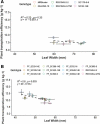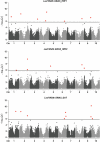Genetic basis of sorghum leaf width and its potential as a surrogate for transpiration efficiency
- PMID: 35933636
- PMCID: PMC9482571
- DOI: 10.1007/s00122-022-04167-z
Genetic basis of sorghum leaf width and its potential as a surrogate for transpiration efficiency
Abstract
Leaf width was correlated with plant-level transpiration efficiency and associated with 19 QTL in sorghum, suggesting it could be a surrogate for transpiration efficiency in large breeding program. Enhancing plant transpiration efficiency (TE) by reducing transpiration without compromising photosynthesis and yield is a desirable selection target in crop improvement programs. While narrow individual leaf width has been correlated with greater intrinsic water use efficiency in C4 species, the extent to which this translates to greater plant TE has not been investigated. The aims of this study were to evaluate the correlation of leaf width with TE at the whole-plant scale and investigate the genetic control of leaf width in sorghum. Two lysimetry experiments using 16 genotypes varying for stomatal conductance and three field trials using a large sorghum diversity panel (n = 701 lines) were conducted. Negative associations of leaf width with plant TE were found in the lysimetry experiments, suggesting narrow leaves may result in reduced plant transpiration without trade-offs in biomass accumulation. A wide range in width of the largest leaf was found in the sorghum diversity panel with consistent ranking among sorghum races, suggesting that environmental adaptation may have a role in modifying leaf width. Nineteen QTL were identified by genome-wide association studies on leaf width adjusted for flowering time. The QTL identified showed high levels of correspondence with those in maize and rice, suggesting similarities in the genetic control of leaf width across cereals. Three a priori candidate genes for leaf width, previously found to regulate dorsoventrality, were identified based on a 1-cM threshold. This study provides useful physiological and genetic insights for potential manipulation of leaf width to improve plant adaptation to diverse environments.
© 2022. The Author(s).
Conflict of interest statement
The authors declare that they have no conflict of interest.
Figures





References
-
- Baldocchi DD, Verma SB, Rosenberg NJ, et al. Microclimate-plant architectural interactions: Influence of leaf width on the mass and energy exchange of a soybean canopy. Agric for Meteorol. 1985;35:1–20. doi: 10.1016/0168-1923(85)90070-X. - DOI
-
- Birch CJ, Hammer GL, Rickert KG. Improved methods for predicting individual leaf area and leaf senescence in maize (Zea mays) Aust J Agric Res. 1998;49:249. doi: 10.1071/A97010. - DOI
MeSH terms
Substances
Grants and funding
LinkOut - more resources
Full Text Sources
Miscellaneous

